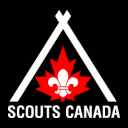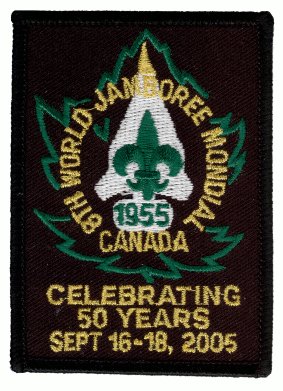Stories
From Nova Scotia to the Jamboree
This is the story of Henry Beer who traveled along with the almost 500 other boys from Nova Scotia to the Jamboree in Ontario. Photos and story courtesy of Mr. Henry Beer.
It was the adventure of a lifetime. A chance to see the world. Well, at least a small representation of the world as it existed in the post-WWII era. The Scout Troops of Pictou County sent a total of 16 Queen's Scouts to the 8th World Jamboree in Niagara-on-the-Lake, Ontario. After months of training and collecting badges and raising money they were ready for the long journey. In the early hours of August 13, 1955 they met on the platform at Stellarton to board a train for Kentville where the entire Nova Scotia contingent would gather. The Pictou Scouts took the name of the Ship Hector which had brought many of their ancestors to N.S. in the 18th century. they were the Hector Troop.
The boys were wide awake and anxious to get started. The station platform was cluttered with kitbags, backpacks, and other scouting paraphernalia. Parents and friends were on hand to wish them a good journey. Finally, at 4:00 AM the special train from Cape Breton pulled in to the station. In spite of the hour, the passenger cars were alive with excited Scouts hanging out the windows and calling to their new friends on the platform. It was time to go.
The eastern sky was brightening as the train pulled out of the station and slowly built up steam as it headed for Truro where it would pick up its final load of passengers. Dawn broke as it chugged towards Truro. Another dozen or so Scouts boarded the train and found seating space on the crowded cars. The next stop was Kentville.
The slow winding trip to Kentville took almost 3 hours, through the Rawdon Hills, across the marshlands, and into the Annapolis Valley. For many of the boys this was the first time they had ever seen this part of Nova Scotia or had been this far from home on their own. It was a warm Saturday morning when the train pulled in. A large crowd had turned out to greet it at the Kentville station and to welcome the visitors to their town. For the next three days Kentvillians would act as host to almost 500 boys from all over Nova Scotia at the pre-jamboree camp. The boys collected their equipment and belongings from the baggage car and marched through the main street of town to the campsite which had been set up on the outskirts. Large military-style bell tents had been set up for them. These would serve as their home-away-from-home for the next two weeks. The adventure had begun.
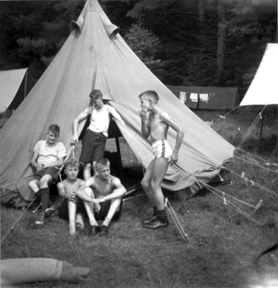
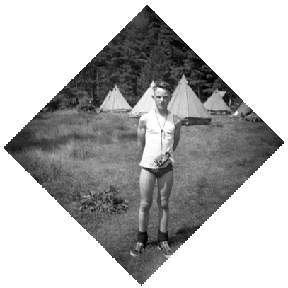
For the next three days the Hector Troop, along with the rest of the Nova Scotia contingent, "polished up" for the big show in Ontario. Daily routines were established. The boys got used to early rising, cooking and kitchen chores, cleaning and taking care of personal belongings, marching in some sense of unison, doing arts and crafts, and learning to take down and put up the bulky canvas tents. On Sunday morning they participated in the church parade in town, showing off for their hosts. During the day there was the swimming pool to keep them cool in the sweltering temperatures and in the evenings there were campfire activities.
On the second night there was a bit of excitement when some of the local teens "raided" the camp grounds and set off firecrackers to keep the boys on their toes. Unfortunately, the campers joined in on the revelry and made too much noise for the liking of the Scout leaders. The next day the boys were "confined to camp" and had to do extra cleanup duties to atone for their sins. However, all was forgiven that evening and numerous visitors came to the camp to join in on the campfire and entertainment put on by the Scouts. The only complaint was the fact that the mosquitoes were out in full force.
Time to break camp. On the morning of August 16th the Nova Scotia contingent arose early and packed up their tents, sleeping bags, utensils, stoves, buckets, washbasins, and personal belongings and left town by train. Destination: Greenwood Air Force Base. The Scouts were to be hosted by the military that night as they made a stopover on their way to Digby. They were welcomed to Greenwood by its commander who gave them the "freedom of the base". This really meant that they would be taken on a guided tour of the base but were warned not to take any pictures of military equipment, especially the Neptune bomber which was stationed there. Since this was during the time of the Cold War, the admonition by the commander added a sense of conspiratorial excitement to the visit. The Scouts were warmly accepted by the base personnel who treated them to a lavish buffet in the mess hall after the tour. After a movie that night the young visitors bunked down on the benches of the base hockey arena. Lights out: 22:00 hours.
Reveille: 500 hours. The contingent of sleepy boys packed up again and marched to the waiting train. It was a two hour journey to Digby where they boarded two Royal Canadian Navy Frigates for the next leg of the trip, across the Bay of Fundy to Saint John. On board they were given full run of the ships except for the bridge and the engine room. Since these were quite small coastal boats, it didn't take long to explore every nook and cranny. The crew entertained the Scouts by setting off depth charges out in the middle of the Bay of Fundy, much to the chagrin of the sea life in the area. The sailors had nicknamed the explosives "Squid Bombs". It was much more exciting than firecrackers.
Upon arrival at Saint John, where they met up with the rest of the Maritime Provinces contingent, the disembarking Boy Scouts were filmed for the local TV news. They had hit the big time. Everyone knew for certain that they were going to be famous. By 4:30 in the afternoon they were rolling out of the city. The CPR had provided sleeping cars which looked like they had been out of service since before World War II, but to a bunch of small town kids from Pictou County it was the Orient Express. Mahogany paneled bunks could be pulled down from overhead for the night. And there was no need for using Boy Scout bed rolls; sheets and blankets were already made up for the night ahead. And for the first time they ate in the "spotlessly clean" dining car complete with silverware, china, and crystal. Service was provided by "French waiters" and "French chefs". Yes, they had hit the big time. That night, the train rumbled through the woods of Maine towards Quebec as the weary travelers slept soundly.
The next morning the boys ate breakfast in the dining car and watched as the scenery outside took on a new look. Instead of rolling, spruce-covered hills the terrain was flatter. The land was without forests and was cultivated with grains and forage for animals. The train tracks now ran straight for miles with few curves. Small farming communities clickety clicked past. The mountains were falling away in the east and the skyline of Montreal was breaking the horizon ahead. The sky was cloudless and the heat of the day was beginning to build.
As the train crept across the Victoria Bridge near Montreal, the windows were opened to allow the breezes off the St. Lawrence to cool the sweaty passengers. Later, at Smith's Falls, Ontario the train stopped for a short while allowing the Scouts time to get down and stretch their legs. A track repair crew was working nearby sending up clouds of dust which added to the discomfort of the day. It gets hot in Ontario in August. It was now five days since the Hector Troop sat on the platform at Stellarton. Some of them were probably wondering if they were ever going to reach their destination in time to participate in the jamboree.
By 4:00 o'clock Thursday afternoon the train rolled into Toronto's Union Station and stopped for about half an hour. The station was alive with commuters. More people in one place than many of the boys had ever witnessed "back home". The excitement of being in the "big city" revived their flagging spirits. They knew for certain that they were almost at the end of their odyssey.
Finally, two hours later, the Maritime contingent transferred to buses at St. Catherine's and rode the last 30 minutes or so to Niagara-on-the-Lake. By the time they had set up their tents and had eaten it was dark. They were exhausted, but they were content. They were finally at the World Jamboree after all their planning, their hard work, and long journey. They crawled into their bed rolls and were lulled to sleep by the sound of planes taking off and landing at the nearby Buffalo Airport. They definitely weren't in Kansas anymore.
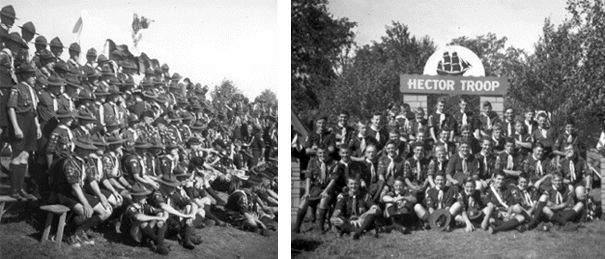
The site of the 8th World Jamboree was Fort George on the west bank of the Niagara River in the town of Niagara-on-the-Lake. The fort was built by the British at the end of the 18th century to serve as headquarters for the British Indian Department in Upper Canada. By the end of the War of 1812 the fort had fallen into ruin and the British abandoned it. It was restored in the 1930's by the Niagara Parks Commission and officially opened to the public in 1950. The parkland surrounding the fort served as campground, parade grounds, and entertainment venue for the thousands of Boy Scouts who came from all over the world. A large temporary grandstand and outdoor stage was constructed on the NPC property to serve as a center for cultural presentations throughout the ten days of the jamboree.
The town of Niagara-on-the-Lake was the center of the world for those ten days. A normally quiet, conservative, rural community was overrun by thousands of teenage boys from every part of the globe. The people of the town went out of their way to make the visitors comfortable. They had set up concession stands on their front lawns selling lemonade, fresh fruit from the region, and hot-dogs to the boys who roamed somewhat aimlessly throughout the downtown area All along the main street the Scouts were approached by children asking for their autographs and asking for souvenir badges. They were treated like celebrities. They had become famous.
The official opening of the Jamboree was Saturday, August 20. Every country's contingent was there for the grand march-past at the open air stadium. The Nova Scotia contingent paraded in with its provincial flags and multi-coloured ribbons twirling in the wind. A troop of kilted Scouts playing bagpipes and drums led the procession. The temperature that day was reported to be 120 degrees in the direct sun. Dozens of scouts who had been standing in the sun for hours fainted under the withering heat as Chief Scout, Governor General Vincent Massey gave his welcoming speech. The crowd was so large that most of the participants could not see the G.G. on the reviewing stand, they could only hear him over the public address system. When the opening ceremonies were concluded the boys marched past the reviewing stand and out of the stadium. They continued to march for another 3 miles before they could break off. Many of the boys took refuge from the heat by heading for the many shower facilities set up for the jamboree. Others headed for the soft drink concessions. Throughout the day hundreds of boys were treated for heat prostration and dehydration by the First Aid stations throughout the site.
The Jamboree site was a self-contained tent city. It had all the amenities of a real city: health care facilities, stores, public utilities, streets, post offices (with their own commemorative postmark), grocery stores, movie theaters, maintenance crews, laundromats, showers and toilet facilities. There was even an on-site newspaper which published every day. Accommodation was basic. The scouts lived in tents of all shapes and sizes. The Scouts from Nova Scotia slept in bell tents which accommodated up to eight campers. Each Scout had his own bed roll which was made up of sheets, blankets, ground sheet, and a pillow. Personal belongings were kept out of the way in kitbags or backpacks. A daily inspection ensured some semblance of tidiness in each tent. Kitchen facilities were primitive but adequate. The main "appliance" which serviced two or three tents was a charcoal burning stove. Other utensils consisted of pots, buckets, metal plates, ladles, etc. Throughout the 10 days, every camper had a chance to show off his culinary skills as each took turn being chief cook and bottle washer for his group of tents. Although quality varied, the menu was wholesome and nutritional.
The overall theme of the Jamboree was cultural harmony - New Horizons. This was the largest Jamboree ever held up until that time, with 10,000 Scouts in attendance . It was only 10 years since the end of World War II and every country in attendance wanted to show the world has much it had progressed since 1945. Each night a grand spectacle was presented at the main grandstand. The biggest production of all was staged by the American contingent. Their show was a version of the Calgary Stampede with chuck wagons, Cowboys and Indians, music, and fireworks. In fact, the American influence was everywhere throughout the Jamboree. They made up the largest contingent next to the Canadians. America was just across the river and the boys from Hector Troop wanted to go to America.
Every participant in the Eighth World Jamboree was issued a special Identification Card by Canada Immigration valid August 18 - 28. It served as their temporary passport. Although they had already passed through the United States by train several nights before, it wasn't the same as walking through US customs at the border. Their big chance came when a day trip was organized to Niagara Falls. The Hector Troop had three goals for the day: find the motel where Marilyn Monroe plotted to kill Joseph Cotton in Niagara; ride on the Maid of the Mist; and go across the Rainbow Bridge to New York state.
The Maid of the Mist did not disappoint; but Marilyn did. The Hector Troop discovered that the motel that played so prominently in Niagara was only a prop built for the film and was torn down when the movie makers left town. Marilyn had left town too.
In Niagara Falls, N.Y. the boys marveled at the trappings of American civilization: Softee Freez ice cream (two flavors entwined on a single cone!), hot-dogs and bagels sold right on the street, souvenirs of the USA such as real wooden nickels. On the cultural side there was the Niagara Falls Museum Tower and Art Gallery which boasted over 700,000 exhibits. Among other objects the museum had on display "...the most interesting collection of deformities in the world. Some of the most Wonderful Freaks of Nature you will ever have the opportunity of viewing, Etc." This was truly the land where dreams came true. And the best part was that the Canadian dollar was worth $1.05 in the good ol' US of A.
The Canadian National Exhibition was the largest agricultural fair in the world. On opening day August 26, over 9,000 scouts were transported to Toronto to be part of the festivities. They marched through the Prince's Gate in their national contingents and were greeted by thousands of fairgoers who lined the avenues to cheer them on. Once the parade broke up, the boys headed for the Food Hall and the Conklin Midway to enjoy the excitement of the big fair. That night they returned to their campsites exhausted but content. The day was a perfect souvenir of the Jamboree experience.
In the final days of the Jamboree, the boys began to think of home. They had experienced the adventure of a lifetime. Everything went off without a hitch and all expectations were exceeded. They would have their memories, souvenirs, stories, and new skills to bring home with them. On the final day they moved to the Arena one last time to attend the closing ceremonies and to say goodbye. This time they walked to the Arena with Scouts from all over the world, no marching, no formal groupings. It was a veritable United Nations. At the end of the ceremonies the Scouts linked arms and sang Auld Lang Syne. The adventure was over; it was time to go home.
Special thanks to Kevin Snair for providing this. The original is on Scouter Kevin's web site, Scouting with Staves & Stetsons.

